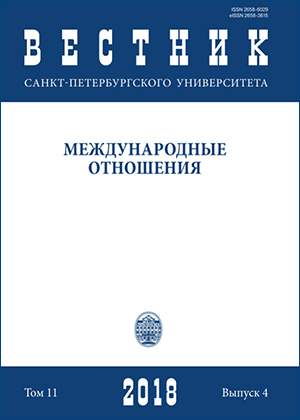Публичная дипломатия в Афганистане, 2002–2018 гг.: влияние США на социальные сети, политическую систему и университеты
DOI:
https://doi.org/10.21638/11701/spbu06.2018.402Аннотация
Исследование раскрывает особенности проектов публичной дипломатии США в Афганистане с 2002 по 2018 г. На основании качественного анализа документов правительства США и количественного анализа «больших данных» социальных сетей выявлены три направления публичной дипломатии США, которые являются инструментом создания нового и лояльного Афганистана: информационные проекты США в социальных сетях, влияние на выборы и гражданское общество, а также трансформация университетов. Авторы пришли к следующим выводам. Во-первых, в социальных сетях США выдерживают жесткую конкуренцию со стороны сторонников талибов, и как только приостанавливают свою информационную работу, антиамериканизм завоевывает афганских пользователей. Более того, большая часть населения Афганистана не имеет доступа в Интернет, что снижает для США возможности влияния в отдаленных провинциях. Во-вторых, изменение политической системы Афганистана посредством поддержки партий, наблюдателей на выборах и развития гражданского общества является наиболее успешным проектом, однако вопросы безопасности и саботаж части традиционного афганского общества ограничивают возможности создания нового политического ландшафта в Афганистане. Наконец, трансформация университетов и американизация учебных планов, структуры, модели обучения и пр. также пробуксовывают в силу постоянного сопротивления со стороны академического сообщества Афганистана.
Ключевые слова:
публичная дипломатия, США, Афганистан, социальные сети
Скачивания
Библиографические ссылки
Remarks by President Trump on the Strategy in Afghanistan and South Asia, August 21, 2017. Available at: https://www.whitehouse.gov/briefings-statements/remarks-president-trump-strategy-afghanistan-southasia/ (accessed 20.06.2018).
The Administration’s 2017 Budget Request for Assistance to Afghanistan and Pakistan. Hearing. House Committee on Foreign Affairs. April 27, 2016. Available at: https://foreignaffairs.house.gov/hearing/jointsubcommittee-hearing-presidents-plan-afghanistan-pakistan-objectives-resources/ (accessed: 20.06.2018).
Hellman M. New Media and the War in Afghanistan: The Significance of Blogging for the Swedish Strategic Narrative. New Media & Society, 2015, vol. 17, no. 1, pp. 6–23.
Shahrani N. The Impact of the 2014 U.S.-NATO Withdrawal on the Internal Politics of Afghanistan. Asian Survey, 2015, vol. 55, no. 2, pp. 273–298.
Maley W. Statebuilding in Afghanistan: Challenges and Pathologies. Central Asian Survey, 2013, vol. 2, no. 3, pp. 255–270.
Social Media in Afghanistan, 2017. Available at: http://www.altaiconsulting.com (accessed: 20.06.2018).
Comprehensive Annual Report on Public Diplomacy and International Broadcasting. U.S. Advisory Commission on Public Diplomacy, 2016. Available at: http://www.state.gov/pdcommission/reports/index.htm (accessed: 20.06.2018).
Performance and Accountability Report, BBG, 2017. Available at: https://www.bbg.gov/wp-content/media/2017/11/BBG_FY_2017_PAR.pdf (accessed: 20.06.2018).
Radio Free Europe/Radio Liberty’s Afghan Service: Radio Azadi. Available at: https://pressroom.rferl.org/p/6122.html (accessed: 20.06.2018).
Annual Report, BBG, 2016. Available at: https://2016.bbg.gov (accessed: 20.06.2018).
Global Audience Estimate from the 2015 Performance and Results Report, BBG, 2015. Available at: https://www.bbg.gov/wp-content/media/2015/11/2015-Global-Audience-Overview-Factsheet.pdf (accessed: 20.06.2018).
Paywast. Cruchbase. Available at: https://www.crunchbase.com/organization/paywast SectionOverview (accessed: 20.06.2018).
Social Media in Afghanistan Takes on Life of its Own. The New York Times, 29.04.2014.
ISIS Online: Countering Terrorist Radicalization and Recruitment on The Internet and Social Media. Hearing. U.S. Senate Committee on Homeland Security and Governmental Affairs. Permanent Subcommittee on Investigations. July 6, 2016. Available at: https://www.hsgac.senate.gov/Subcommittees/Investigations/Hearings/Isis-Online-Countering-Terrorist-Radicalization-And-Recruitment-On-TheInternet_Social-Media (accessed: 20.06.2018).
Internet World Statistics. Available at: https://www.internetworldstats.com/asia.htm (accessed: 20.06.2018).
Democracy Assistance, U.S. Government Accountability Office, 2017. Available at: www.gao.gov (accessed: 20.06.2018).
Supporting Elections in Afghanistan, USAID Associate Cooperative Agreement, 2005. Available at: http://pdf.usaid.gov/pdf_docs/PDACF485.pdf (accessed: 20.06.2018).
Audit of Support to the Electoral Process and Support for Increased Electoral Participation in Afghanistan Programs, USAID, 2011. Available at: http://pdf.usaid.gov/pdf_docs/PDACS021.pdf (accessed: 20.06.2018).
Afghanistan Election Observation Mission. Final Report, USAID, 2014. Available at: http://pdf.usaid.gov/pdf_docs/PA00KJ4X.pdf (accessed: 20.06.2018).
Monthly Report Advancing Efforts for Reform and Civic Accountability, 2016. Available at: www.usaid.gov (accessed: 20.06.2018).
Afghanistan Electoral Reform and Civic Advocacy Agreement, USAID, 2016. Available at: http://pdf.usaid.gov/pdf_docs/PDACT899.pdf (accessed: 20.06.2018).
Tsvetkova N. Americanisation, Sovietisation, And Resistance at Kabul University: Limits of The Educational Reforms. History of Education, 2017, vol. 46, no. 3, pp. 343–365.
Scott-Smith G. Mapping the Undefinable: Some Thoughts on the Relevance of Exchange Programmes within International Relations Theory. Annals of The Academy of Political and Social Science, 2008, no. 616, pp. 173–195.
Hopf T. The Promise of Constructivism in International Relations Theory. International Security, 1998, vol. 23, no. 1, pp. 171–200.
Afghanistan’s Higher Education Project, USAID, 2008. Available at: http://pdf.usaid.gov/pdf_docs/PDACS021.pdf (accessed: 20.06.2018).
Afghanistan Consultation Workshop Report, USAID, 2002. Available at: http://pdf.usaid.gov/pdf_docs/PA00MT83.pdf (accessed: 20.06.2018).
Afghanistan Higher Education Project. Final Evaluation, USAID, 2011. Available at: http://pdf.usaid.gov/pdf_docs/PDACS007.pdf (accessed: 20.06.2018).
University Support and Workforce Development Program, 2016. Available at: www.usaid.gov (accessed: 20.06.2018).
Institutional Partnerships Program. Annual Progress Report, 2003. Available at: http://pdf.usaid.gov/pdf_docs/PDACG185.pdf (accessed: 20.06.2018).
Afghanistan Education Programs: Analysis and Lessons Learned Study, USAID, 2016. Available at: http://pdf.usaid.gov/pdf_docs/PA00KJ4X.pdf (accessed: 20.06.2018).
Mid-Term Evaluation of the American University of Afghanistan, 2016. Available at: http://pdf.usaid.gov/pdf_docs/PA00M7QW.pdf (accessed: 20.06.2018).
Pre-Certification Assessment of American University of Afghanistan, 2016. Available at: http://pdf.usaid.gov/pdf_docs/PA00MDG1.pdf (accessed: 20.06.2018).
Загрузки
Опубликован
Как цитировать
Выпуск
Раздел
Лицензия
Статьи журнала «Вестник Санкт-Петербургского университета. Международные отношения» находятся в открытом доступе и распространяются в соответствии с условиями Лицензионного Договора с Санкт-Петербургским государственным университетом, который бесплатно предоставляет авторам неограниченное распространение и самостоятельное архивирование.




